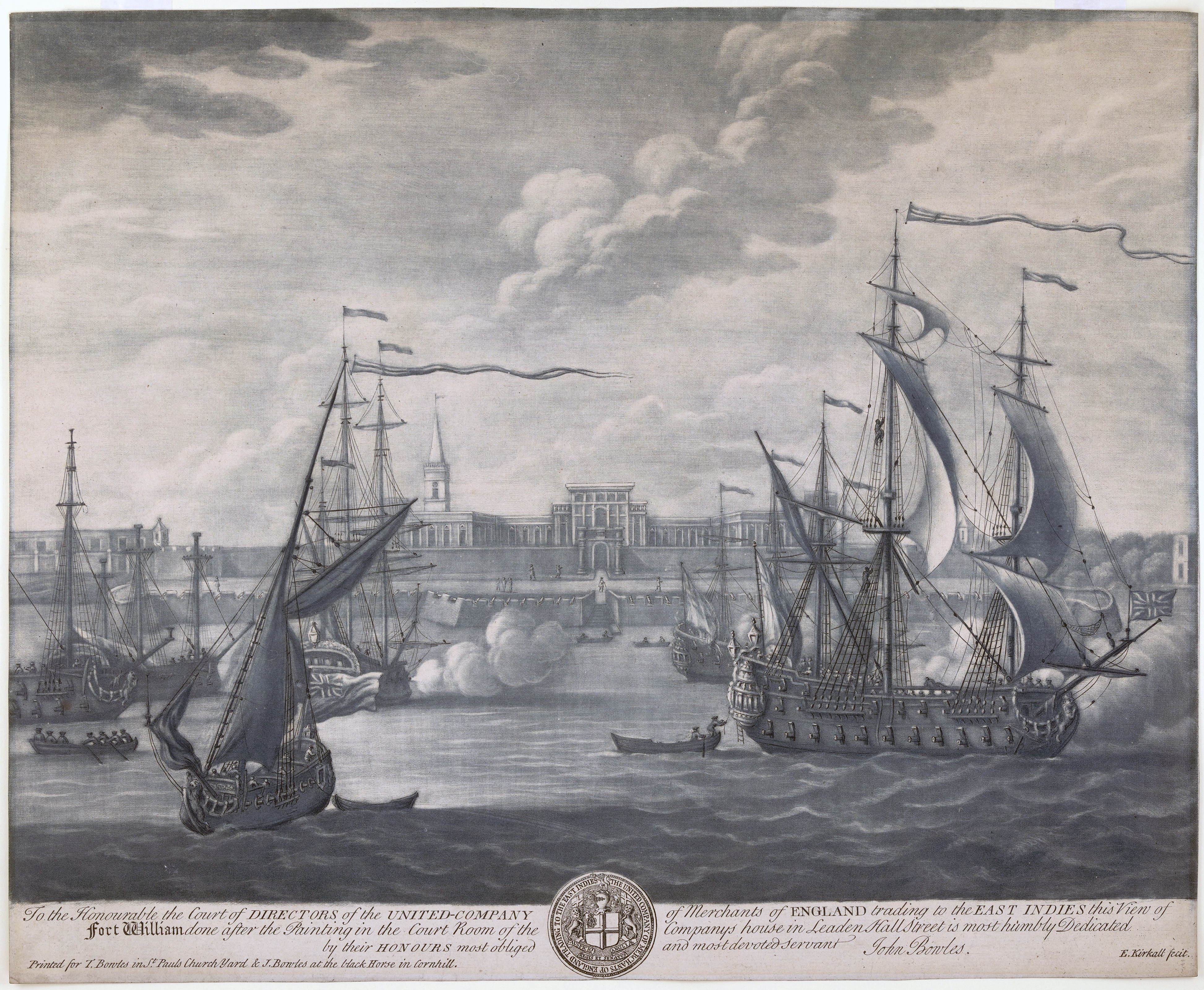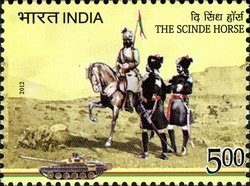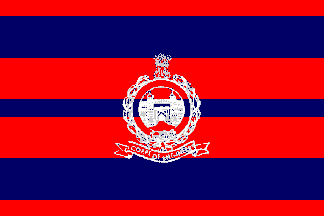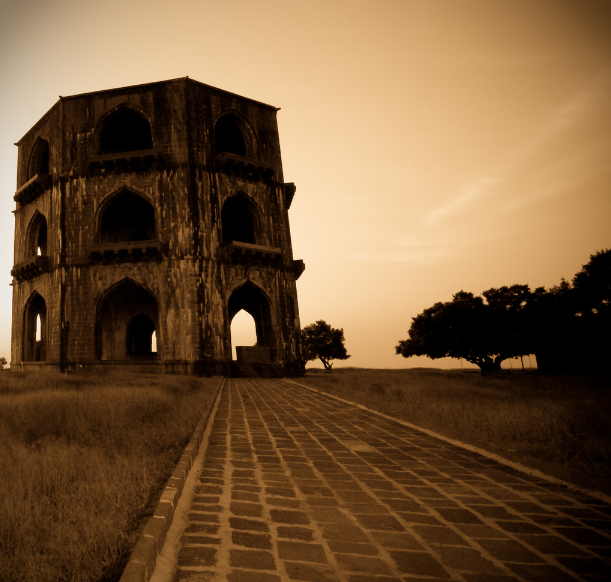|
252nd Indian Armoured Brigade
The 252nd Indian Armoured Brigade was an armoured formation of the Indian Army. It was formed from the 3rd (Meerut) Cavalry Brigade when it was dispersed and reformed as the 2nd Indian Armoured Brigade in 1940, from July 1941 as 2nd Independent Armoured Brigade Group and the 252nd Indian Independent Armoured Brigade Group in December 1941. In January 1942 it was attached to the 10th Indian Infantry Division. Thereafter it served with the 31st Indian Armoured Division (from July 1942 redesignated 252nd Indian Armoured Brigade) in the Middle East until being redesignated 2nd Indian Independent Armoured Brigade in December 1945. It returned to India in January 1946 and was redesignated 2nd Armoured Brigade ndependentin June 1946. As 2nd Armoured Brigade ndependentit was located in August 1947 at Ahmednagar. In October 1962 it was stationed at Babina. In 1965 it was part of XI Corps. In December 1971 it was placed under command of 39th Infantry Division. Assigned to new 31st Armoured ... [...More Info...] [...Related Items...] OR: [Wikipedia] [Google] [Baidu] |
British India
The provinces of India, earlier presidencies of British India and still earlier, presidency towns, were the administrative divisions of British governance on the Indian subcontinent. Collectively, they have been called British India. In one form or another, they existed between 1612 and 1947, conventionally divided into three historical periods: *Between 1612 and 1757 the East India Company set up factories (trading posts) in several locations, mostly in coastal India, with the consent of the Mughal emperors, Maratha Empire or local rulers. Its rivals were the merchant trading companies of Portugal, Denmark, the Netherlands, and France. By the mid-18th century, three ''presidency towns'': Madras, Bombay and Calcutta, had grown in size. *During the period of Company rule in India (1757–1858), the company gradually acquired sovereignty over large parts of India, now called "presidencies". However, it also increasingly came under British government oversight, in effect shar ... [...More Info...] [...Related Items...] OR: [Wikipedia] [Google] [Baidu] |
13th Duke Of Connaught's Own Lancers
The 13th Lancers is an armoured regiment of Pakistan Army. It was formed in 1923 as 13th Duke of Connaught's Own Lancers by the amalgamation of 31st Duke of Connaught's Own Lancers and 32nd Lancers. On Partition of India in 1947, the regiment was allotted to Pakistan.Ahmad, Lt Col RN. (2010). ''Battle Honours of the Baloch Regiment''. Abbottabad: The Baloch Regimental Centre. It is the senior-most armoured regiment of Pakistan Army. Formation The two parent regiments of 13th Lancers had a common origin in the old Bombay Squadron of Cavalry, raised for service in the Second Anglo-Maratha War. The squadron was split to form the 1st and 2nd Regiments of Bombay Light Cavalry in 1817. More than a hundred years later, they were reunited to form the 13th Duke of Connaught's Own Bombay Lancers in 1923.Cadell, Sir Patrick. (1938). ''History of the Bombay Army''. London: Longmans & Green. 31st Duke of Connaught's Own Lancers The 1st Bombay Light Cavalry served in the First Afghan War in 183 ... [...More Info...] [...Related Items...] OR: [Wikipedia] [Google] [Baidu] |
Armoured Brigades Of The British Indian Army
Armour (British English) or armor (American English; see spelling differences) is a covering used to protect an object, individual, or vehicle from physical injury or damage, especially direct contact weapons or projectiles during combat, or from a potentially dangerous environment or activity (e.g. cycling, construction sites, etc.). Personal armour is used to protect soldiers and war animals. Vehicle armour is used on warships, armoured fighting vehicles, and some mostly ground attack combat aircraft. A second use of the term ''armour'' describes armoured forces, armoured weapons, and their role in combat. After the development of armoured warfare, tanks and mechanised infantry and their combat formations came to be referred to collectively as "armour". Etymology The word "armour" began to appear in the Middle Ages as a derivative of Old French. It is dated from 1297 as a "mail, defensive covering worn in combat". The word originates from the Old French , itself derive ... [...More Info...] [...Related Items...] OR: [Wikipedia] [Google] [Baidu] |
List Of Indian Army Brigades In World War II
The Indian Army during World War II fought on three continents Europe, Africa and Asia. They also had to supply formations for home service. This list details the Cavalry, Armoured and Infantry brigades formed by the Indian Army during World War II. Cavalry brigades *1st (Risalpur) Cavalry Brigade *3rd (Meerut) Cavalry Brigade *4th (Secunderabad) Cavalry Brigade Armoured brigades *50th Indian Tank Brigade * 251st Indian Tank Brigade previously called 1st Indian Armoured and 251st Indian Armoured Brigade * 252nd Indian Armoured Brigade previously called 2nd Indian Armoured Brigade *254th Indian Tank Brigade previously called 4th Indian Armoured and 254th Indian Armoured Brigade * 255th Indian Tank Brigade previously called 5th Indian Armoured and 255th Indian Armoured Brigade *267th Indian Armoured Brigade * 268th Indian Armoured Brigade converted to 268th Indian Infantry Brigade October 1942 Motor brigades *1st Indian Motor Brigade designated, but actually formed as 1st Indian ... [...More Info...] [...Related Items...] OR: [Wikipedia] [Google] [Baidu] |
14th Prince Of Wales's Own Cavalry
The Scinde Horse is an armoured regiment in the Armoured Corps of the Indian Army. The regiment, known before independence as the 14th Prince of Wales's Own Scinde Horse was a regular cavalry regiment of the Bombay Army, and later the British Indian Army. Scinde Horse is the only regiment known to honour its enemy till date (the Baluchi warrior on its badge) and has not changed its badge since its raising. At one point, the regiment carried nine Standards while on parade (regiments normally hold one), a unique privilege given to it for its valour. The regiment was the first Cavalry unit in the British Indian Army to get mechanized (at Rawalpindi, in 1938). It was also the first Cavalry regiment to get the President of India's Standard after independence. Formation The regiment can trace its formation back to The Scinde Irregular Horse raised at Hyderabad on 8 August 1839. The regiment was raised at the recommendation of Colonel Henry Pottinger, the Resident at Scinde. The fi ... [...More Info...] [...Related Items...] OR: [Wikipedia] [Google] [Baidu] |
Indian Engineers
The Indian Army Corps of Engineers is a combat support arm which provides combat engineering support, develops infrastructure for armed forces and other defence organisations and maintains connectivity along the borders, besides helping the civil authorities during natural disasters. College of Military Engineering, Pune (CME) is the premier technical and tactical training institution of the Indian Army Corps of Engineers. The Corps consists of three groups of combat engineers, namely the Madras Sappers, the Bengal Sappers and the Bombay Sappers. It has a long history dating back to the mid-18th century. The earliest existing subunit of the Corps (18 Field Company) dates back to 1777 while the Corps officially recognises its birth as 1780 when the senior-most group of the Corps, the Madras Sappers were raised. A group is roughly analogous to a brigade of the Indian infantry, each group consisting of a number of engineer regiments. The engineer regiment is the basic combat engine ... [...More Info...] [...Related Items...] OR: [Wikipedia] [Google] [Baidu] |
Royal Artillery
The Royal Regiment of Artillery, commonly referred to as the Royal Artillery (RA) and colloquially known as "The Gunners", is one of two regiments that make up the artillery arm of the British Army. The Royal Regiment of Artillery comprises thirteen Regular Army regiments, King's Troop, Royal Horse Artillery, the King's Troop Royal Horse Artillery and five Army Reserve (United Kingdom), Army Reserve regiments. History Formation to 1799 Artillery was used by the English army as early as the Battle of Crécy in 1346, while Henry VIII established it as a semi-permanent function in the 16th century. Until the early 18th century, the majority of British regiments were raised for specific campaigns and disbanded on completion. An exception were gunners based at the Tower of London, Portsmouth and other forts around Britain, who were controlled by the Ordnance Office and stored and maintained equipment and provided personnel for field artillery Artillery is a class of heav ... [...More Info...] [...Related Items...] OR: [Wikipedia] [Google] [Baidu] |
4th Bombay Grenadiers
The Grenadiers is an infantry regiment of the Indian Army, formerly part of the Bombay Army and later the pre-independence British Indian Army, when the regiment was known as the 4th Bombay Grenadiers. It has distinguished itself during the two world wars and also since the Independence of India. The regiment has won many battle honours and gallantry awards, and is considered to be one of India's most decorated regiments with three Param Vir Chakra awardees in three different conflicts. History Early history The oldest grenadier regiment of the armies in the Commonwealth belongs to the Indian Army. The concept of 'Grenadiers' evolved from the practice of selecting the bravest and strongest men for the most dangerous tasks in combat. The Grenadiers have the longest unbroken record of existence in the Indian Army.Sharma, p. 75 The history of the Indian Grenadiers is linked to the troops recruited for the army of the Bombay Presidency. The very first mention of a grenadier comp ... [...More Info...] [...Related Items...] OR: [Wikipedia] [Google] [Baidu] |
14th/20th Hussars
The 14th/20th King's Hussars was a cavalry regiment of the British Army. It was created by the amalgamation of the 14th King's Hussars and the 20th Hussars in 1922 and, after service in the Second World War, it amalgamated with the Royal Hussars to become the King's Royal Hussars in 1992. History The regiment, which was initially styled the 14th/20th Hussars, was created by the amalgamation of the 14th King's Hussars and the 20th Hussars in 1922. It was re-titled the 14th/20th King's Hussars in December 1936. The regiment, which was based in India at the start of the Second World War, dispatched a cadre of personnel to form the 26th Hussars in February 1941. The remainder of the regiment was deployed to Iraq and Persia later that year to guard the oil fields. It landed in Italy in 1944 and then took part in the capture of Medicina in April 1945. After the war the regiment remained in Germany until 1946 when it moved to Cambrai Lines at Catterick Garrison as RAC Training Re ... [...More Info...] [...Related Items...] OR: [Wikipedia] [Google] [Baidu] |
4th Duke Of Cambridge's Own Hodson's Horse
4th Horse (Hodson's Horse) is a part of the Indian Army Armoured Corps, Armoured Corps of the Indian Army, which had its beginnings as an irregular cavalry regiment during the time of the Indian Rebellion of 1857. Formation The regiment was raised during the turbulent times of the Indian Rebellion of 1857. During the siege of Delhi, on 19 May 1857, an order was issued by the Commander-in-Chief, India, Commander-in-Chief, Major General George Anson (British Army officer, born 1797), George Anson to appoint Lieutenant (later Brevet (military), Brevet Major) William Stephen Raikes Hodson as the Commandant of a corps of Irregular Horse, which he was directed to raise, while at Karnal, Kurnaul. Hodson sought assistance from Robert Montgomery (colonial administrator), Robert Montgomery, Judicial Commissioner of the List of governors of Punjab (British India), Punjab. Montgomery asked two Sardar, Sirdars to raise a rissalah (troop) each, and he raised one himself. The three rissalahs l ... [...More Info...] [...Related Items...] OR: [Wikipedia] [Google] [Baidu] |
British Crown
The Crown is the state (polity), state in all its aspects within the jurisprudence of the Commonwealth realms and their subdivisions (such as the Crown Dependencies, British Overseas Territories, overseas territories, Provinces and territories of Canada#Provinces, provinces, or states and territories of Australia, states). Legally ill-defined, the term has different meanings depending on context. It is used to designate the monarch in either a personal capacity, as Head of the Commonwealth, or as the king or queen of their realms (whereas the monarchy of the United Kingdom and the monarchy of Canada, for example, are distinct although they are in personal union). It can also refer to the rule of law; however, in common parlance 'The Crown' refers to the functions of executive (government), government and the civil service. Thus, in the United Kingdom (one of the Commonwealth realms), the government of the United Kingdom can be distinguished from the Crown and the state, in prec ... [...More Info...] [...Related Items...] OR: [Wikipedia] [Google] [Baidu] |
Ahmednagar
Ahmednagar (), is a city located in the Ahmednagar district in the state of Maharashtra, India, about 120 km northeast of Pune and 114 km from Aurangabad. Ahmednagar takes its name from Ahmad Nizam Shah I, who founded the town in 1494 on the site of a battlefield where he won a battle against superior Bahamani forces. It was close to the site of the village of Bhingar. With the breakup of the Bahmani Sultanate, Ahmad established a new sultanate in Ahmednagar, also known as Nizam Shahi dynasty. Ahmednagar has several dozen buildings and sites from the Nizam Shahi period. Ahmednagar Fort, once considered almost impregnable, was used by the British to house Jawaharlal Nehru (the first prime minister of India) and other Indian Nationalists before Indian independence. A few rooms there have been converted to a museum. During his confinement by the British at Ahmednagar Fort in 1944, Nehru wrote the famous book '' The Discovery of India''. Ahmednagar is home to the Ind ... [...More Info...] [...Related Items...] OR: [Wikipedia] [Google] [Baidu] |

.jpg)



.jpg)
